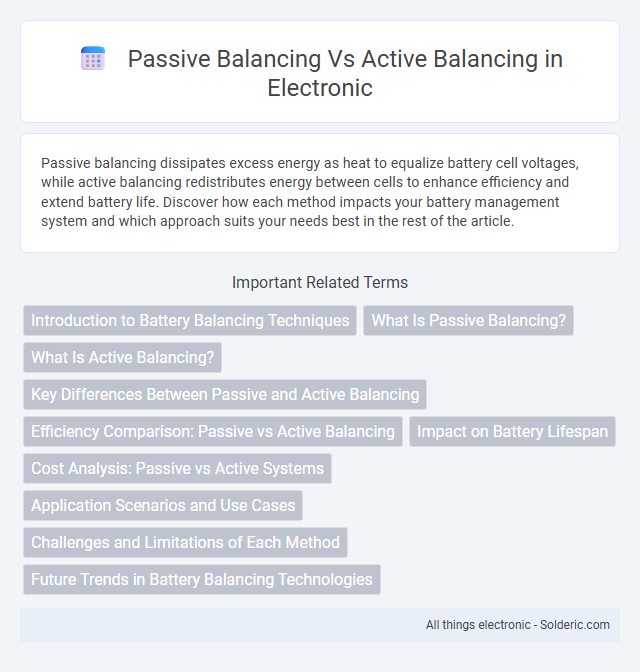Passive balancing dissipates excess energy as heat to equalize battery cell voltages, while active balancing redistributes energy between cells to enhance efficiency and extend battery life. Discover how each method impacts your battery management system and which approach suits your needs best in the rest of the article.
Comparison Table
| Aspect | Passive Balancing | Active Balancing |
|---|---|---|
| Definition | Balances battery cells by dissipating excess energy as heat. | Transfers energy between cells to balance charge without energy loss. |
| Efficiency | Lower efficiency due to energy dissipation. | Higher efficiency; conserves overall battery energy. |
| Complexity | Simple circuitry and control. | Complex circuitry with active energy transfer components. |
| Cost | Lower cost and easy implementation. | Higher initial cost and maintenance. |
| Applications | Small to medium battery packs. | Large battery systems requiring high efficiency. |
| Thermal Management | Requires heat dissipation components. | Minimal heat generation, reducing cooling needs. |
| Balancing Speed | Slower balancing rate. | Faster and more precise balancing. |
Introduction to Battery Balancing Techniques
Battery balancing techniques are essential for maintaining the longevity and performance of multi-cell battery packs by ensuring all cells charge and discharge evenly. Passive balancing dissipates excess energy from higher-charged cells as heat through resistors, making it simpler but less energy-efficient. Active balancing transfers energy between cells using inductors or capacitors, optimizing battery capacity and enhancing Your battery's overall cycle life.
What Is Passive Balancing?
Passive balancing is a battery management technique that equalizes individual cell voltages by dissipating excess energy as heat through resistors, ensuring all cells reach the same charge level. This method is simpler, cost-effective, and commonly used in low-power applications, but it is less efficient since energy is wasted during balancing. Your battery system's longevity and safety can benefit from passive balancing by preventing overcharging of stronger cells while maintaining overall pack health.
What Is Active Balancing?
Active balancing is a battery management technique that redistributes charge between cells using energy transfer circuits, enhancing battery efficiency and lifespan by preventing overcharging and deep discharge of individual cells. Unlike passive balancing, which dissipates excess energy as heat, active balancing transfers energy from higher-charged cells to lower-charged ones, optimizing your battery pack's overall performance. This method is particularly beneficial for applications requiring high energy density and long cycle life, such as electric vehicles and renewable energy storage systems.
Key Differences Between Passive and Active Balancing
Passive balancing dissipates excess energy as heat through resistors, making it simpler and more cost-effective but less energy-efficient. Active balancing redistributes energy between cells using capacitors or inductors, enhancing efficiency and battery lifespan by maintaining uniform charge levels. Your choice depends on priorities like cost, efficiency, and system complexity.
Efficiency Comparison: Passive vs Active Balancing
Passive balancing dissipates excess energy as heat through resistors, resulting in lower efficiency, especially in high-capacity battery packs. Active balancing transfers energy between cells using inductors or capacitors, significantly improving efficiency and extending battery life. Choosing active balancing can optimize your battery system's performance by reducing energy loss and enhancing overall energy management.
Impact on Battery Lifespan
Passive balancing dissipates excess energy as heat, which can cause gradual battery wear and reduced lifespan due to energy loss. Active balancing transfers energy between cells, minimizing stress and improving overall battery health and longevity. Your battery's lifespan benefits significantly more from active balancing through efficient energy redistribution and reduced thermal strain.
Cost Analysis: Passive vs Active Systems
Passive balancing systems generally incur lower initial costs due to simpler circuit designs and fewer components. Active balancing, while more expensive upfront because of sophisticated control electronics and additional hardware, offers greater efficiency and extends battery lifespan, potentially reducing long-term replacement and maintenance expenses. Your choice between passive and active balancing should weigh initial setup budgets against anticipated operational savings and performance benefits.
Application Scenarios and Use Cases
Passive balancing is commonly applied in low-cost, small-scale battery systems such as consumer electronics and basic energy storage units, where simplicity and cost-efficiency are critical. Active balancing suits high-performance applications like electric vehicles and large-scale renewable energy storage, offering improved efficiency and longevity by redistributing charge between battery cells. Understanding your energy system's scale and performance requirements helps determine whether passive or active balancing is the optimal choice.
Challenges and Limitations of Each Method
Passive balancing faces challenges such as energy inefficiency due to continuous power dissipation as heat, limiting battery life and system runtime. Active balancing requires complex circuitry and higher costs, which can increase system complexity and affect reliability. Your choice depends on balancing efficiency priorities versus budget and design constraints.
Future Trends in Battery Balancing Technologies
Future trends in battery balancing technologies emphasize increased adoption of active balancing due to its higher efficiency and ability to extend battery life by redistributing energy among cells rather than dissipating it as heat. Innovations in semiconductor materials and energy management algorithms are enhancing the precision and speed of active balancing systems, making them suitable for electric vehicles and grid storage applications. Your investment in advanced active balancing technology can improve overall battery performance and support the transition to sustainable energy solutions.
Passive balancing vs Active balancing Infographic

 solderic.com
solderic.com